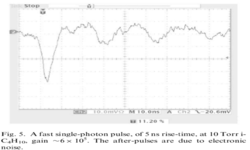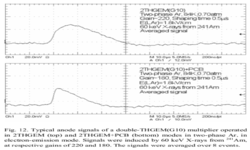Difference between revisions of "H Proposal Defense"
| Line 89: | Line 89: | ||
| + | <math> Z_{eff}=Z [1-A exp\left(-B\frac{\nu}{\nu_o Z^{\frac{3}{2}}}\right)] | ||
Revision as of 23:54, 23 April 2011
1.)neutron fission event happens GEANT Simulation give probability of event
2.) Assume one of the fission fragments escapes material and enter gas volume
3.) Use Italian paper to report experimental result on how many electron are liberated from the average fission fragment.
4.)TGEM amplifies the liberated electrons producing X electrons hitting the charge collector.
5.) The electrons are assume to arrive over a time interval T
6.) The resulting current passes through a 50 Ohm resistor producing a voltage difference which is measured on an oscilloscope.
7.) The signal observed by others is ??
Topic
The Performance of Thick Gaseous Electron Multiplier Preamplifiers (THGEM) as a Neutron Sensitive Detector.
Introduction
What is main point of the paragraph. 1st sentence in paragraph introduces the main point. 2-4 sentences supporting the main point. 3 - 5 summarized the point
I propose to construct and measure the performance of a fission chamber which has been instrumented with preamplifiers known a Thick Gas Electron Multipliers (THGEM). This fission chamber is a gas chamber filled with an inert gas enclosing a fissionable target material, like Uranium or Thorium. The fissionable material will produce fission fragments when an incident neutron of sufficient energy impacts material. The fission fragments which are within 5 microns of the target's surface may escape the target as ions and ionize the gas in the chamber. Electrons freed from the ionization gas can be amplified by the THGEM preamplifier and transported to charge collectors using strong electric fields.
A THGEM preamplifier is a perforated fiberglass board (PC board). The design is based upon the Gas Electron Multiplier (GEM) invented by Fabio Sauli in 1997<ref name="Sauli1997">F. Sauli, et al, NIM A386, (1997) 531-534 </ref >. The GEM preamplifier is a 50 micron sheet of kapton that is coated on each side with 5 microns of copper. The copper clad kapton is perforated with 50-100 micron diameter holes in a staggered array separated by 100-200 microns. The THGEM preamplifier is more macroscopic using a 2 mm thick fiberglass sheet perforated with holes that are 2 mm in diameter.
Strong electric fields are established by supplying a potential difference between the two sides of the kapton, or in the THGEM , the fiberglass. The electric field lines transport liberated electrons through the preamplifier holes. For the GEM foils, the smaller diameter of the hole can provide sufficient amplification using a potential difference of 350 V between the two sides. On the other hand, the THGEM with the larger hole diameter requires a higher potential difference of about 2000 Volts to achieve similar amplifications.
The objective of this work will be to construct a THGEM based ionization chamber. The THGEM will follow a proven design(Ref THGEM design) and use a resistive paste to reduce discharge events. The detector may be made sensitive to neutrons by doping the resistive paste with a fissionable material. The doping step will take place once a working THGEM equipped detector has been shown to work. This fission chamber-like device will have the advantage of measuring the location of the incident neutrons on the face of the detector using a segmented charge collector.
Chapter 1
Fission Fragment Ionization of Argon
Ionization is the liberation of electrons from the confines of an atom. The minimum amount of energy required to liberate the electron is referred to as the ionization energy. Energy transferred to the electron in excess of this ionization energy will appear in the form of the ejected electron's kinetic energy. Photons or charged particles interacting with a gas volume can induce ionization. The ionization process depends stochastically on the ionization cross section which is mainly affected by the fission fragment energy, type of the fission fragment (heavy or light), the gas pressure in the chamber, and the atomic properties of the gas.
The ionized nuclei that are ejected from a heavy nucleus which has undergone the fission process can ionize atoms in the vicinity of the fission event. These ejected nuclei are referred to as fission fragments. The fission fragments have path lengths in matter which are on the order of microns. The energy loss process that these fission fragments undergo over the short range may be astochastically described in terms of three steps; as the fission fragment is totally ionized, fission fragment is exchanging the charge with the gas atoms, and as the fission fragment is totally neutralized.
Firstly, as the fission fragment is totally ionized (without any bounded electrons), the total energy of is represented by :
where Z1 M,v are atomic number, the mass and the velocity of the fission fragment directly after the fission reaction. Coulomb force is including the repulsion force between the ionized gas atoms and fission fragment, in addition to, the attraction force between the fission fragment and electrons. But in at this moment the first term is dominant,since the fission fragment collision is causes the electrons to scatter away from the fission fragment.
Secondly, when the fission fragment decelerates, a charge exchange between the fission fragment and gas atoms, the electrons are even scattering away from the nucleus or attached to the nucleus as it is moving. The total energy loss of the fission fragment suggested by Bohr in 1940 is :
where N is the number of particles of the stopping medium per cubic centimeter.
M1 and M2 are masses of the fragment and the absorber.
Z1 and Z2 are the atomic number of the fragment and the absorber.
e is the electron charge.
v is the fragment velocity.
Z1 effective is the charge of the fragment, changes from 20 for the beginning of the track to a value of 2 close to the end of the track.
a12 scr is an impact parameter which tells at what distance the energy loss in the nuclear collisions is effectively zero owing to the screening of the charges of the nuclei by the atomic electrons.
w = I/h_bar is the average oscillation frequency of the electrons in the atom.<ref name="Hyde">The Nuclear Properties of the Heavy Elements 3, Earl K. Hyde,Denver Publications, 1971, p 195-210 </ref>
This formula is a first trial to evaluate the total energy loss by the fission fragment under each stage of charge carrier exchange between the fission fragment and the gas atoms, it is based on how accurate is the value of Z-effective at each stage, this will cause the first term to be dominant by the beginning of the motion of the fission fragment, but the second term is bigger close to the end of the fission fragment track.<ref name="Hyde"/>
Recently, Bethe's theory is used to estimate the energy loss for fission fragment which involves using diverse model for the effective charge obtained based on experimental data analysis for the energy loss.<ref name="Rykov">V.A Rykov, atomic energy,vol83,No.1,1997 </ref>
.
The parameter is known as the Townsend coefficient. The THGEM preamplifier is 1 mm thick and establishes an electric field (E) of when a [otentail difference of 2 kV is applied between the top and bottom sides of the plate. The gas chamber contains a 1 Atm mixture that is 90% Argon and 10 % C02 by volume. The parameters from reference <ref name="Sharma"> A.Sharma,F. Sauli, first tawsend coefficients measurements for argon gas european organization for nuclear research (1993) </ref > are not given for this mixture. To estimate the THGEM pre-amplification, the A and B parameters for a 96/4 mixture gas mixture were used which are 5.04 and 90.82 respectively . Using the above equation we would expect to be about per cm which is a factor of 30 less than the coefficient for a GEM foil. A free electron traveling through the 0.1 cm THGEM hole should produce 12 additional freed electrons due to the Electric field of the THGEM pre-amplifier. We would expect a single freed electron to produce a maximum of 10^3 electrons using three THGEM pre-amplifiers.
For a single ionization event, the detector signal would be small while for a fission even the number of freed electrons will be substantially larger resulting in a large signal.
We need an ion to produce a factor of 40 more electrons than a electron or photon traversing the drift region. The number electron emitted from a fission fragment is 5.1*10^12/cm^3.s as result of a 30 MeV proton projected toward a U-238 target<ref name=""> M. Facina "A gas catcher for the selective production of radioactive beams through laser ionization" mater thesis, Leuven 2004 </ref > which is enough to have a good signal.
The 10^2 eletrons impinging the first THGEM foils will be amplified by a factor of 10^6 using three THGEm pramplifiers.
20 mV/50 \Omega 50 \times 10^-9 1e /10^{-19} Coul = 2 \times 10^8 electrons.
When the fission event happens using 1 MeV neutron, Cd-123 is one of the expected fission fragment scattered with a kinetic energy of 81.6 MeV based on GEANT4 simulation. The kinetic energy range of the emitted electrons by ionization is 1-1.4 keV. As the electron passes through the THGEM cards with velocity of 1.8-2.1*10^7 cm/s (Assuming all the electrons are going to have a constant velocity until it reaches the read out card), an expected signal of about 6-7 uV. Expecting to produce 10^4 primary electrons at least from fission fragments ionization , so a minimum signal of 60-70 mV will appear on the oscilloscope using 50 ohm resistor for only one electron passes a distance of 0.5 cm from the last THGEM card to the read out card in 23-27 ns.
Radiation Backgound for Th-232 and U-238 Decay
The background energy spectrum for Th-232 has a main peak for alpha decay of energy 4082.8(14) keV combined with gamma rays of energy 63.81(1) keV and intensity 26.3(13) percent.<ref name="Th-232"> http://home.fnal.gov/~hannahnp/decay/decay.html, Jan.5 2011,http://atom.kaeri.re.kr/cgi-bin/nuclide?nuc=Th-232</ref >.
U-238 has also a close background spectrum as being mainly an alpha emitter, but decay alpha energy is 4274(5) keV with less gamma
intensity 1.02(15) percent when its energy is 113.5(1) keV.<ref name="U-238"> Fermilab,http://home.fnal.gov/~hannahnp/decay/decay.html, Jan.5 2011,http://home.fnal.gov/~hannahnp/decay/U238.html</ref >
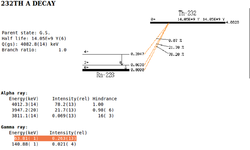 .<ref name="Th-232_d"> http://home.fnal.gov/~hannahnp/decay/decay.html, Jan.6 2011,http://atom.kaeri.re.kr/cgi-bin/decay?Th-232%20A </ref > |
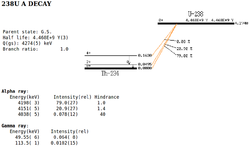 .<ref name="U-238_d"> http://home.fnal.gov/~hannahnp/decay/decay.html, Jan.6 2011,http:http://atom.kaeri.re.kr/cgi-bin/decay?U-238%20A </ref > |
The ionization from alpha particles and gamma rays is considered negligible compared to the one for any fission fragment,because of the enormous difference in mass, charge and kinetic energy. But when the fission fragments are absent, there will always be a signal representing the alpha decay.
Neutron fission X-sect for U-238 and Th-232
The cross section is the proportionality constant for the relationship between the particle travelling distance dx and its probability to make an interaction.
The cross section values are represented as a function of energy. The importance of these curves gives the value of the cross section for each energy and shows the resonance peaks. Theoretically, there is not any model that gives a detailed prediction of cross section curve, but statistically it is possible to evaluate the parameters for an assumption that describes part of the cross section curve within a certain error.
Neutron fission is one of the interactions commonly taking place spontaneously or under certain experimental conditions. An incident neutron with a certain kinetic energy hits a nucleus, if the energy is enough to go over Coulomb barrier then the neutron produces new nuclei (fragments) and particles. The new products interact with the surrounding medium depending on their energy and the type of the surrounding medium.
Neutrons are classified depending on their kinetic energy into three types: thermal, intermediate, and fast neutrons. The following table shows the range of each type and additional types of neutrons that are important in applications with neutron energy less than the intermediate range.
| Type | Energy |
| Thermal | 0.025 eV |
| Epithermal | 0.025 eV – 0.2 eV |
| Resonance | 1 eV – 1000 eV |
| Intermediate | 1 keV – 500 keV |
| Fast | > 0.5 MeV |
<ref name="Dostal">General principles of neutron activation analysis, J. Dostal and C. Elson,p 28 Figure 2.3.</ref> <ref name="James">7-Ch. Jammes, P. Filliatre, B. Geslot, L. Oriol, F. Berhouet, J-F. Villard, “Research activities in fission chamber modeling in support of the nuclear energy industry”, ANIMMA International Conference, 7-10 June 2009, Marseille, France </ref>
U-238 and Th-232 belong to the actinides. They are characterized with relatively high neutron fission cross section for fast neutrons (specifically for neutron energy higher than 1.5 MeV ).
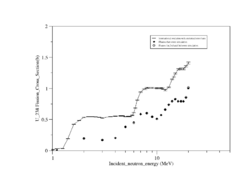
|
Efficiency and Sensitivity of THGEM
The efficiency of a detector is the ratio of the detected events to the total number of events emitted by a source. The intrinsic efficiency has the same definition but it is independent on the detector geometry, and basically considers the interaction cross section of the incident particle with the detector material.<ref name="William"/>
Efficiency requires maximizing the rate of interactions by an appropriate choice for neutron fission sensitive material and the thickness of the sputtered layer over the THGEM cards. Also increasing ionization rate for the fragments under a certain pressure in a highly dense electric field environment, the last condition demands a thorough study for the voltage applied on THGEM cards and distances between them.
Sensitivity is a scale for the detector's ability to output a usable signal as a result of a particle interaction within the detector.<ref name="James"> Ch. Jammes, P. Filliatre, B. Geslot, L. Oriol, F. Berhouet, J-F. Villard,“Research activities in fission chamber modeling in support of the nuclear energy industry”, ANIMMA International Conference, 7-10, June 2009, Marseille, France.</ref>
The sensitivity of THGEM as a neutron detector mainly depends on neutron energy range, material cross sections for ionization, neutrons rates of interactions, detector mass, background, noise (sparking and electronic devices used to collect the signal), materials surrounding the detectors and the strength of the electric field.<ref name="James"/> <ref name="William">William R. Leo,Techniques for nuclear and particle physics experiments,1st edition,Springer Verlag, 1995.</ref>
THGEM detector is going to give a digital signal, coming from a defined localized point on the read out plate. This will give information about the real sensitive area of detector to the detected electrons which will be considered a reference for a new size of the future detectors used for the same purpose.
Furthermore, the detected signal will show the energy(s) where the detector is going to be the most sensitive if a calibration curve is available.
Expectations
THGEM as a neutron detector physical properties will be investigated. A clear experimental procedure to get the maximum gain with the least sparking through the detection process. Also, a comparison between the detector efficiency using Th-232 and U-238 and the effect of thickness of coated material on the efficiency. Finally, recommendations will be suggested to improve the next neutron detector design.
For Later
Manufacturing Environment and Detector Aging
Gaseous Detector manufacturing environment is always established to avoid any external effect that may interrupt the detector work. These effects come from the surrounding atmospheric environment of the detector like oxidization and dust accumulation. Also the effects appear in the working environment for the detector as it is surrounded with a noble gas like argon with contaminants under a high electric field effect; this produces chemical radicals attracted to the anode and causes non conducting anode. Finally, coating the THGEM cards by deposition used under a high electric field produces secondary electron emission from the coating, as a result reducing the life time of the of the THGEM cards.<ref name="Grupen">Particle Detectors, Claus Grupen & Boris Shwartz, 2nd edition, 2008 </ref>
Decrease the effect of the detector aging can relatively be controlled. Working in a clean room helps to avoid the contaminants carried by the surrounding atmosphere, and adding filters to the gas source decreases the contaminants carried by the gas.
Least fission fragment K.E needed for ionization
Ionization and Number of the the electrons produced
References
<references/>
Paul Reuss ,Neutron physics,L'editeur EDP Sciences,2008.
